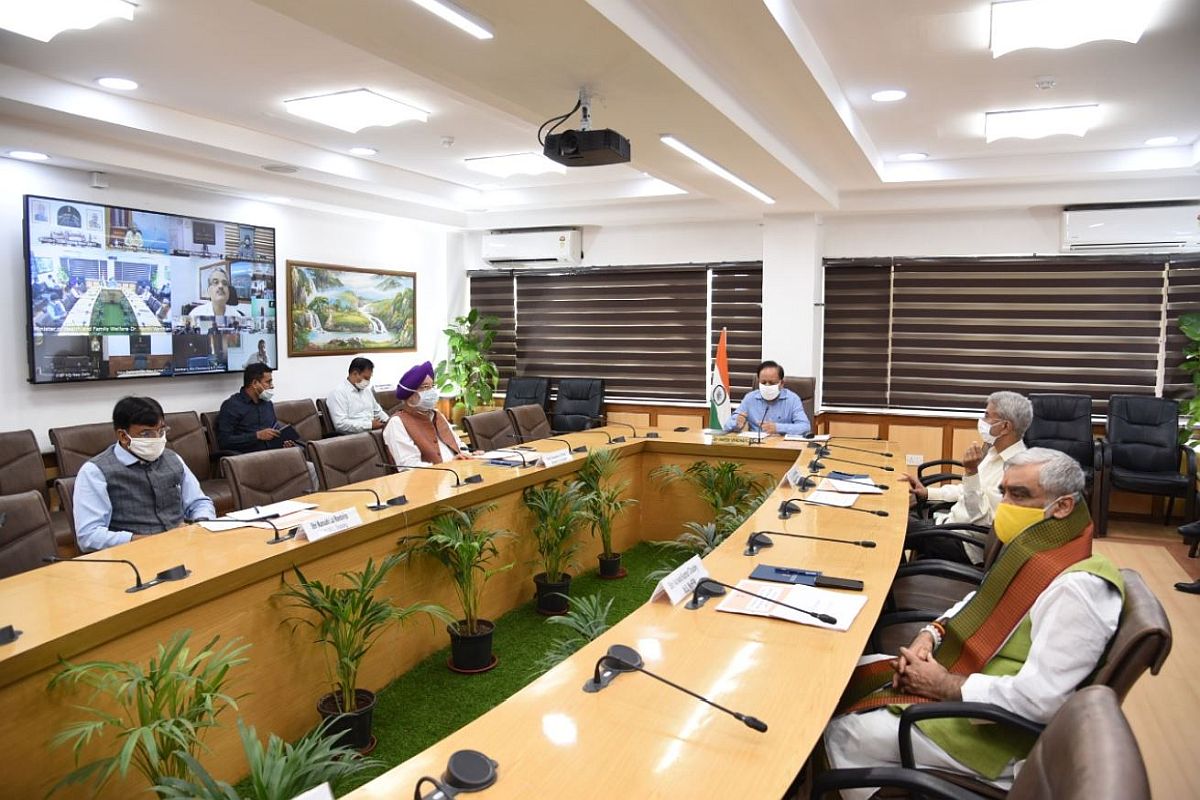With the number of Coronavirus cases zooming past the 7-lakh mark in India, the Group of Ministers (GoM) meeting headed by Union Health and Family Welfare Minister Harsh Vardhan was held to take stock of the COVID-19 situation in the country at the Nirman Bhawan in Delhi on Thursday.
Addressing the concern that India has become the third worst Coronavirus hit country in terms of cases, Harsh Vardhan said that it is necessary to see this in a correct perspective as India is a country with the second highest population in the world.
Advertisement
Despite being one of most populated countries, India’s cases per million are 538, while the world average is 1,453, the health minister said.
Vardhan further reiterated that there is no community transmission in India as of now. “There may be some localised pockets where transmission is high but as a country, there is no community transmission,” he told reporters after the Group of Ministers meeting.
Eight states, including Maharashtra, Tamil Nadu, Delhi, Karnataka and Telangana, account for around 90 per cent of the active COVID-19 cases in the country and 80 per cent of the active cases have been reported from 49 districts, the GoM on COVID-19 was informed.
Besides, the GoM was told that six states — Maharashtra, Delhi, Gujarat, Tamil Nadu, Uttar Pradesh and West Bengal — account for 86 per cent of the deaths caused by COVID-19 and 32 districts account for 80 per cent of such fatalities, the Union health ministry said.
The GoM, which held its 18th meeting was informed that there was a special focus on the regions showing a higher COVID-19 fatality rate, the ministry said.
“A global comparison between the five most-affected countries clearly depicted that India has one of the lowest numbers of cases per million (538) and deaths per million (15), compared to the global average of 1,453 and 68.7 respectively,” the ministry said in a statement.
with regard to the COVID-19 healthcare infrastructure in India, the GoM was informed that as on Thursday, there were 3,914 facilities across the country with 3,77,737 isolation beds (without ICU support), 39,820 ICU beds and 1,42,415 oxygen-supported beds, along with 20,047 ventilators.
Over 21.3 crore N95 masks, 1.2 crore personal protective equipment (PPE) kits and 6.12 crore hydroxychloroquine tablets have so far been distributed, the GoM was told.
“As we move forward, our focus shall be on the management of COVID-19 through strict containment measures and surveillance, utilising the full testing capacity, monitoring of the co-morbid and elderly population, predicting the emerging hotspots, leveraging digital tools such as Aarogya Setu, ensuring seamless patient admission processes and infrastructure preparedness (critical-care beds, oxygen, ventilators and logistics),” Vardhan said.
“Along with the states and Union territories, our aim is to reduce and keep the case fatality rate low by early identification and effective clinical management,” he was quoted as saying in a statement issued by the ministry.
During Unlock 2.0, the future steps would include a sharp focus on containment and surveillance, including demarcation of containment zones and notifying such areas on the health ministry website.
It includes strict perimeter control with only essential activities allowed, intensive contact-tracing, house-to-house search or surveillance and buffer zones to be identified outside the containment zones.
Dr Sujeet K Singh, Director, National Centre for Disease Control, presented a detailed report on the surveillance efforts undertaken in India during the pandemic, the ministry said.
The focus was on a strict containment strategy and surveillance through SARI/ILI cases, serological survey and enhancing the laboratory network for testing.
The major concern areas in the country were highlighted and the measures to be taken listed, including a timely clinical management, along with testing and surveillance in the high-risk population with co-morbidities, to reduce the case fatality ratio.
In a detailed presentation by Amit Khare, Chairman of the Empowered Group-8 (on information, communication and public awareness), the GoM was briefed on the key steps taken regarding communication of information and raising public awareness.
The group received 6,755 alerts of fake news, of which 5,890 were replied to directly and rebuttals published to 17 foreign media stories. The group also coordinated the issue of 98 daily COVID-19 bulletins, 92 media briefings and 2,482 press releases.
The group played a pro-active role in the behavioural change campaign during the pandemic and creating awareness regarding the relief measures among farmers and MSMEs under the “Atmanirbhar Bharat Abhiyan” launched by Prime Minister Narendra Modi, the ministry said.
It was highlighted that the mental health issues related to the COVID-19 pandemic will be a major part of the communication strategy going forward through discussions in the media, the ministry said.
There was also a special focus on dissemination of messages and information in regional languages, it added.
Harsh Vardhan was joined by External Affairs Minister S Jaishankar, Civil Aviation Minister Hardeep Singh Puri, Minister of State for Health Ashwini Kumar Choubey and Minister of State, Chemical and Fertilisers and Shipping Mansukh Mandaviya.
Dr Vinod Paul, Member (Health), Niti Aayog, also joined the meeting through video-conferencing.
India’s Coronavirus tally rose to 7,67,296 on Thursday which includes 2,69,789 active cases and 4,76,377 recovered cases. The death toll due to the virus has climbed to 21,129.
The country has reported the highest single-day surge of 24,879 new cases in 24 hours.
The last high-level meeting was held on June 27 to review, monitor and evaluate the evolving situation. The meeting was chaired by Harsh Vardhan himself through video conferencing.
During the meeting, it was stated that 85.5 per cent of active cases and 87 per cent of total deaths were reported from eight states — Maharashtra, Tamil Nadu, Delhi, Telangana, Gujarat, Uttar Pradesh, Andhra Pradesh and West Bengal.
(With PTI inputs)











